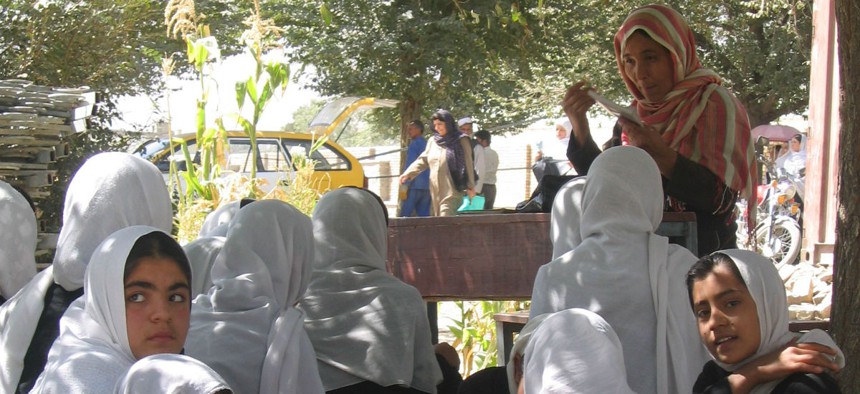It's Unclear Whether U.S. Investments in Afghan Education Are Paying Off
Watchdog faults State, Pentagon and USAID for weak assessments of $759.6 million in spending.
The grim news from war-torn Afghanistan keeps on coming.
The United States’ multi-agency investment of $759.6 million in more than a decade of seeking improvements in Afghan education cannot be thoroughly assessed or precisely tracked, a watchdog said in a report released Thursday morning.
The Defense and State departments and the U.S. Agency for International Development to varying degrees “have not adequately assessed their efforts to support education in Afghanistan,” said the Special Inspector General for Afghanistan Reconstruction. “While USAID had a defined strategy for primary and secondary education in Afghanistan, DoD and State did not.”
USAID in 2014 cited Afghan government data showing increased student enrollment from 900,000 students in 2002 to 8 million in 2013 “as evidence of overall progress in the sector,” SIGAR wrote. “Importantly, USAID is not able to demonstrate how its specific education programs are linked to supporting these Afghan-reported results and cannot verify whether this Afghan data is reliable.”
Separate assessments from the Afghan Education Ministry and independent sources “have raised significant concern that the MOE's education data may not accurately reflect the true number of students enrolled in Afghanistan,” auditors wrote.
Discussions of Defense Department efforts to build educational capacity “had little to do with DoD education-related efforts were limited to USAID efforts, including outputs such as the numbers of teachers trained and numbers of schools constructed,” the report said. But “DoD officials told us the department does not have specific primary and secondary education strategic objectives against which to evaluate the success of its programs, projects and other efforts in support of Afghan education.”
The State Department did not evaluate on-the-ground education efforts at a deep level, the report said, and did not aggregate the evaluations it produced based on embassy guidance on monitoring individual programs into an overall assessment.
“Without comprehensive assessments of the work performed in education, DoD, State and USAID will be unable to determine the impact that the approximately $759.6 million they have spent has had in improving Afghan education,” auditors concluded.
The inspector general recommended that the USAID administrator the agency’s plan for Afghan education by providing clear descriptions of other U.S. agencies’ roles, responsibilities and accountability for helping to implement the strategy, and developing a sector-wide assessment with verified data. And SIGAR recommended that the “secretaries of Defense and State assess the extent to which the education efforts funded by their respective departments, to include primary and secondary education, have led to improvements in education or increased stability in Afghanistan.”
State did not concur with the recommendation, saying its primary and secondary education projects make up less than 1 percent of the total funding reviewed in the audit and that it has already evaluated its efforts on an individual project basis. The Defense Department partially agreed, adding funds for a more-comprehensive study. USAID officials concurred with the three recommendations addressed to the agency.




